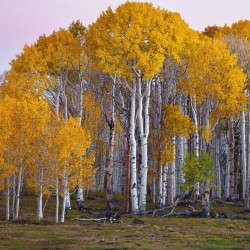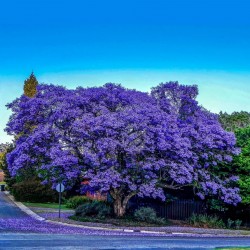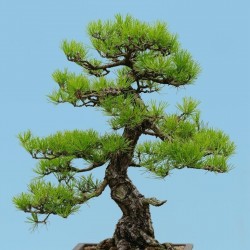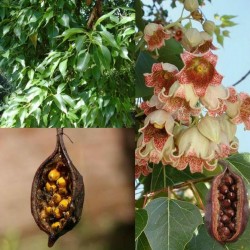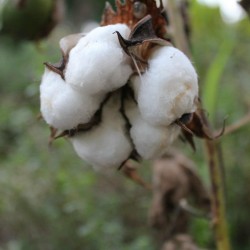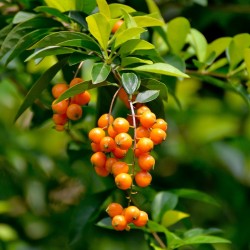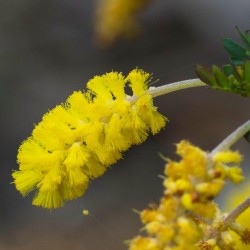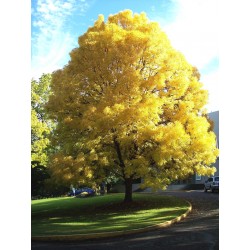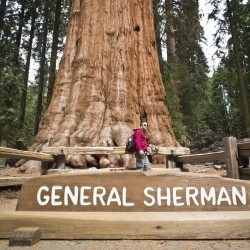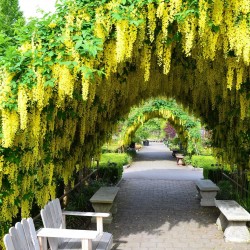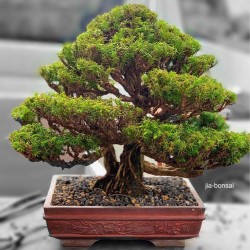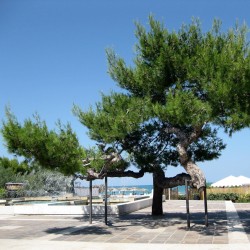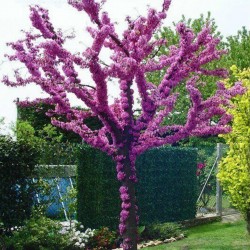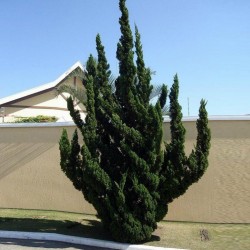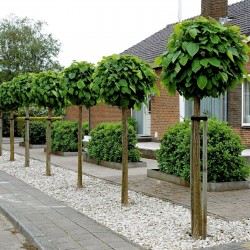Seeds Gallery EU,
5/
5
<div id="more_info_sheets" class="sheets align_justify">
<div id="idTab1" class="rte">
<h2><span style="font-size: 14pt;"><strong>Giant Sequoia Seeds Bonsai (Sequoiadendron giganteum)</strong></span></h2>
<h2><span style="color: #ff0000; font-size: 14pt;"><strong>Price for Package of 5 seeds.</strong></span></h2>
<p><i style="font-size: 14px;"><b>Sequoiadendron giganteum</b></i><span style="font-size: 14px;"> </span><span style="font-size: 14px;">(</span><b style="font-size: 14px;">giant sequoia</b><span style="font-size: 14px;">; also known as</span><span style="font-size: 14px;"> </span><b style="font-size: 14px;">giant redwood</b><span style="font-size: 14px;">,</span><span style="font-size: 14px;"> </span><b style="font-size: 14px;">Sierra redwood</b><span style="font-size: 14px;">,</span><span style="font-size: 14px;"> </span><b style="font-size: 14px;">Sierran redwood</b><span style="font-size: 14px;">,</span><span style="font-size: 14px;"> </span><b style="font-size: 14px;">Wellingtonia</b><span style="font-size: 14px;"> </span><span style="font-size: 14px;">or simply</span><span style="font-size: 14px;"> </span><b style="font-size: 14px;">big tree</b><span style="font-size: 14px;">—a nickname also used by</span><span style="font-size: 14px;"> </span>John Muir<sup id="cite_ref-2" class="reference">[2]</sup><span style="font-size: 14px;">) is the sole living species in the genus</span><span style="font-size: 14px;"> </span><i style="font-size: 14px;">Sequoiadendron</i><span style="font-size: 14px;">, and one of three species of</span><span style="font-size: 14px;"> </span>coniferous<span style="font-size: 14px;"> </span>trees<span style="font-size: 14px;"> </span><span style="font-size: 14px;">known as</span><span style="font-size: 14px;"> </span>redwoods<span style="font-size: 14px;">, classified in the family</span><span style="font-size: 14px;"> </span>Cupressaceae<span style="font-size: 14px;"> </span><span style="font-size: 14px;">in the subfamily</span><span style="font-size: 14px;"> </span>Sequoioideae<span style="font-size: 14px;">, together with</span><span style="font-size: 14px;"> </span><i style="font-size: 14px;">Sequoia sempervirens</i><span style="font-size: 14px;"> </span><span style="font-size: 14px;">(coast redwood) and</span><span style="font-size: 14px;"> </span><i style="font-size: 14px;">Metasequoia glyptostroboides</i><span style="font-size: 14px;"> </span><span style="font-size: 14px;">(dawn redwood). Giant sequoia specimens are the most massive trees on Earth.</span><sup id="cite_ref-usda_3-0" class="reference">[3]</sup><span style="font-size: 14px;"> </span><span style="font-size: 14px;">The common use of the name</span><span style="font-size: 14px;"> </span><i style="font-size: 14px;">sequoia</i><span style="font-size: 14px;"> </span><span style="font-size: 14px;">usually refers to</span><span style="font-size: 14px;"> </span><i style="font-size: 14px;">Sequoiadendron giganteum</i><span style="font-size: 14px;">, which occurs naturally only in groves on the western slopes of the</span><span style="font-size: 14px;"> </span>Sierra Nevada<span style="font-size: 14px;"> </span><span style="font-size: 14px;">Mountains of California.</span></p>
<div>
<p>The etymology of the genus name has been presumed—initially in<span> </span><i>The Yosemite Book</i><span> </span>by<span> </span>Josiah Whitney<span> </span>in 1868<sup id="cite_ref-cnps1_4-0" class="reference">[4]</sup>—to be in honor of<span> </span>Sequoyah<span> </span>(1767–1843), who was the inventor of the<span> </span>Cherokee syllabary.<sup id="cite_ref-natcomp_5-0" class="reference">[5]</sup><span> </span>An etymological study published in 2012, however, concluded that the name was more likely to have originated from the Latin<span> </span><i>sequi</i><span> </span>(meaning<span> </span><i>to follow</i>) since the number of seeds per cone in the newly-classified genus fell in mathematical sequence with the other four genera in the suborder.<sup id="cite_ref-cnps2_6-0" class="reference">[6]</sup></p>
<h2><span class="mw-headline" id="Description">Description</span></h2>
<div class="thumb tleft">
<div class="thumbinner"><img alt="" src="https://upload.wikimedia.org/wikipedia/commons/thumb/2/20/Daniel_Fuchs.CC-BY-SA.Sequoiadendron_giganteum.jpg/220px-Daniel_Fuchs.CC-BY-SA.Sequoiadendron_giganteum.jpg" width="220" height="150" class="thumbimage">
<div class="thumbcaption">
<div class="magnify"></div>
Leaves of<span> </span><i>Sequoiadendron giganteum</i></div>
</div>
</div>
<p>Giant sequoia specimens are the most massive individual trees in the world.<sup id="cite_ref-usda_3-1" class="reference">[3]</sup><span> </span>They grow to an average height of 50–85 m (164–279 ft) with trunk diameters ranging from 6–8 m (20–26 ft). Record trees have been measured at 94.8 m (311 ft) tall. Trunk diameters of 17 m (56 ft) have been claimed via research figures taken out of context.<sup id="cite_ref-Flint_2002_7-0" class="reference">[7]</sup><span> </span>The specimen known to have the greatest<span> </span>diameter at breast heightis the<span> </span>General Grant tree<span> </span>at 8.8 m (28.9 ft).<sup id="cite_ref-8" class="reference">[8]</sup><span> </span>Between 2014 and 2016, specimens of<span> </span>coast redwood<span> </span>were found to have greater trunk diameters than all known giant sequoias.<sup id="cite_ref-mdvaden.com_9-0" class="reference">[9]</sup><span> </span>The trunks of coast redwoods taper at lower heights than those of giant sequoias which have more columnar trunks that maintain larger diameters to greater heights.</p>
<p>The oldest known giant sequoia is 3,500 years old based on<span> </span>dendrochronology. Giant sequoias are among<span> </span>the oldest living organisms<span> </span>on Earth. Giant sequoia bark is fibrous, furrowed, and may be 90 cm (3 ft) thick at the base of the columnar trunk. The bark provides significant protection from fire damage. The leaves are<span> </span>evergreen, awl-shaped, 3–6 mm (<span class="frac nowrap"><sup>1</sup>⁄<sub>8</sub></span>–<span class="frac nowrap"><sup>1</sup>⁄<sub>4</sub></span> in) long, and arranged spirally on the shoots.</p>
<div class="thumb tleft">
<div class="thumbinner"><img alt="" src="https://upload.wikimedia.org/wikipedia/commons/thumb/e/e4/Sequoiadendron_giganteum_MHNT.BOT.2004.0.191.jpg/220px-Sequoiadendron_giganteum_MHNT.BOT.2004.0.191.jpg" width="220" height="199" class="thumbimage">
<div class="thumbcaption">
<div class="magnify"></div>
Giant sequoia cones and seed</div>
</div>
</div>
<p>The giant sequoia regenerates by<span> </span>seed. The seed<span> </span>cones<span> </span>are 4–7 cm (<span class="frac nowrap">1<span class="visualhide"> </span><sup>1</sup>⁄<sub>2</sub></span>–3 in) long and mature in 18–20 months, though they typically remain green and closed for as long as 20 years. Each cone has 30–50 spirally arranged scales, with several seeds on each scale, giving an average of 230 seeds per cone. Seeds are dark brown, 4–5 mm (0.16–0.20 in) long, and 1 mm (0.04 in) broad, with a 1-millimeter (0.04 in) wide, yellow-brown wing along each side. Some seeds shed when the cone scales shrink during hot weather in late summer, but most are liberated by insect damage or when the cone dries from the heat of fire. Young trees start to bear cones after 12 years.</p>
<p>Trees may produce sprouts from their stumps subsequent to injury, until about 20 years old; however, shoots do not form on the stumps of mature trees as they do on coast redwoods. Giant sequoias of all ages may sprout from their<span> </span>boles<span> </span>when branches are lost to fire or breakage.</p>
<p>A large tree may have as many as 11,000 cones. Cone production is greatest in the upper portion of the canopy. A mature giant sequoia disperses an estimated 300–400 thousand seeds annually. The winged seeds may fly as far as 180 m (590 ft) from the parent tree.</p>
<p>Lower branches die readily from being shaded, but trees younger than 100 years retain most of their dead branches. Trunks of mature trees in groves are generally free of branches to a height of 20–50 m (70–160 ft), but solitary trees retain lower branches.</p>
<h2><span class="mw-headline" id="Biology">Biology</span></h2>
<p>Because of its size, the tree has been studied for its water pull. Water from the roots can be pushed up only a few meters by<span> </span>osmotic pressure<span> </span>but can reach extreme heights by using a system of branching<span> </span>capillarity(capillary action) in the tree's<span> </span>xylem<span> </span>(the water tubules) and sub-pressure from evaporating water at the leaves.<sup id="cite_ref-10" class="reference">[10]</sup><span> </span>Sequoias supplement water from the soil with fog, taken up through<span> </span>air roots, at heights to where the root water cannot be pulled.</p>
<h2><span class="mw-headline" id="Distribution">Distribution</span></h2>
<div class="thumb tright">
<div class="thumbinner"><img alt="" src="https://upload.wikimedia.org/wikipedia/commons/thumb/6/69/A014%2C_Sequoia_National_Park%2C_California%2C_USA%2C_1998.jpg/220px-A014%2C_Sequoia_National_Park%2C_California%2C_USA%2C_1998.jpg" width="220" height="147" class="thumbimage">
<div class="thumbcaption">
<div class="magnify"></div>
The<span> </span>Generals Highway<span> </span>passes between giant sequoias in Sequoia National Park</div>
</div>
</div>
<p>The natural distribution of giant sequoias is restricted to a limited area of the western<span> </span>Sierra Nevada,<span> </span>California. They occur in scattered groves, with a total of 68 groves (see<span> </span>list of sequoia groves<span> </span>for a full inventory), comprising a total area of only 144.16 km<sup>2</sup><span> </span>(35,620 acres). Nowhere does it grow in pure stands, although in a few small areas, stands do approach a pure condition. The northern two-thirds of its range, from the<span> </span>American River<span> </span>in<span> </span>Placer County<span> </span>southward to the<span> </span>Kings River, has only eight disjunct groves. The remaining southern groves are concentrated between the Kings River and the Deer Creek Grove in southern<span> </span>Tulare County. Groves range in size from 12.4 km<sup>2</sup><span> </span>(3,100 acres) with 20,000 mature trees, to small groves with only six living trees. Many are protected in<span> </span>Sequoia<span> </span>and<span> </span>Kings Canyon National Parks<span> </span>and<span> </span>Giant Sequoia National Monument.</p>
<p>The giant sequoia is usually found in a humid climate characterized by dry summers and<span> </span>snowy<span> </span>winters. Most giant sequoia groves are on granitic-based residual and<span> </span>alluvial<span> </span>soils. The elevation of the giant sequoia groves generally ranges from 1,400–2,000 m (4,600–6,600 ft) in the north, to 1,700–2,150 metres (5,580–7,050 ft) to the south. Giant sequoias generally occur on the south-facing sides of northern mountains, and on the northern faces of more southerly slopes.</p>
<p>High levels of reproduction are not necessary to maintain the present population levels. Few groves, however, have sufficient young trees to maintain the present density of mature giant sequoias for the future. The majority of giant sequoias are currently undergoing a gradual decline in density since European settlement.</p>
<p>While the present day distribution of this species is limited to a small area of California, it was once much more widely distributed in prehistoric times, and was a reasonably common species in North American and Eurasian coniferous forests until its range was greatly reduced by the last<span> </span>ice age. Older fossil specimens reliably identified as giant sequoia have been found in<span> </span>Cretaceous<span> </span>era sediments from a number of sites in North America and Europe, and even as far afield as New Zealand<span> </span>and Australia.</p>
<p>A group of sequoias was planted and is naturally propagating on<span> </span>Mount San Jacinto<span> </span>in<span> </span>Riverside County, southern California. The trees were planted by the<span> </span>United States Forest Service<span> </span>after a 1974 wildfire.<sup id="cite_ref-14" class="reference">[14]</sup></p>
<h2><span class="mw-headline" id="Ecology">Ecology</span></h2>
<div class="thumb tright">
<div class="thumbinner"><img alt="" src="https://upload.wikimedia.org/wikipedia/en/thumb/7/7b/Sequoia_trees.JPG/220px-Sequoia_trees.JPG" width="220" height="165" class="thumbimage">
<div class="thumbcaption">
<div class="magnify"></div>
Two giant sequoias,<span> </span>Sequoia National Park. The right-hand tree bears a large fire scar at its base; fires do not typically kill the trees but do remove competing thin-barked species, and aid giant sequoia regeneration.</div>
</div>
</div>
<p>Giant sequoias are in many ways adapted to forest fires. Their bark is unusually fire resistant, and their cones will normally open immediately after a fire.<sup id="cite_ref-15" class="reference">[15]</sup><span> </span>The giant sequoias are having difficulty reproducing in their original habitat (and very rarely reproduce in cultivation) due to the seeds only being able to grow successfully in full sun and in mineral-rich soils, free from competing vegetation. Although the seeds can germinate in moist needle<span> </span>humus<span> </span>in the spring, these seedlings will die as the duff dries in the summer. They therefore require periodic<span> </span>wildfire<span> </span>to clear competing vegetation and soil humus before successful regeneration can occur. Without fire, shade-loving species will crowd out young sequoia seedlings, and sequoia seeds will not germinate. When fully grown, these trees typically require large amounts of water and are therefore often concentrated near streams.</p>
<p>Fires also bring hot air high into the canopy via<span> </span>convection, which in turn dries and opens the cones. The subsequent release of large quantities of seeds coincides with the optimal postfire<span> </span>seedbed<span> </span>conditions. Loose ground ash may also act as a cover to protect the fallen seeds from<span> </span>ultraviolet radiation<span> </span>damage.</p>
<p>Due to fire suppression efforts and livestock grazing during the early and mid 20th century, low-intensity fires no longer occurred naturally in many groves, and still do not occur in some groves today. The suppression of fires leads to ground fuel build-up and the dense growth of fire-sensitive<span> </span>white fir, which increases the risk of more intense fires that can use the firs as ladders to threaten mature giant sequoia crowns. Natural fires may also be important in keeping<span> </span>carpenter ants<span> </span>in check.<sup id="cite_ref-16" class="reference">[16]</sup></p>
<p>In 1970, the<span> </span>National Park Service<span> </span>began controlled burns of its groves to correct these problems. Current policies also allow natural fires to burn. One of these untamed burns severely damaged the second-largest tree in the world, the<span> </span>Washington tree, in September 2003, 45 days after the fire started. This damage made it unable to withstand the snowstorm of January 2005, leading to the collapse of over half the trunk.</p>
<p>In addition to fire, two animal agents also assist giant sequoia seed release. The more significant of the two is a<span> </span>longhorn beetle<span> </span>(<i>Phymatodes nitidus</i>) that lays eggs on the cones, into which the larvae then bore holes. Reduction of the vascular water supply to the cone scales allows the cones to dry and open for the seeds to fall. Cones damaged by the beetles during the summer will slowly open over the next several months. Some research indicates many cones, particularly higher in the crowns, may need to be partially dried by beetle damage before fire can fully open them. The other agent is the<span> </span>Douglas squirrel<span> </span>(<i>Tamiasciurus douglasi</i>) that gnaws on the fleshy green scales of younger cones. The squirrels are active year round, and some seeds are dislodged and dropped as the cone is eaten.</p>
<h2><span class="mw-headline" id="Discovery_and_naming">Discovery and naming</span></h2>
<div class="thumb tright">
<div class="thumbinner"><img alt="" src="https://upload.wikimedia.org/wikipedia/commons/thumb/b/bd/Giant_sequoia_exhibitionism.jpg/220px-Giant_sequoia_exhibitionism.jpg" width="220" height="296" class="thumbimage">
<div class="thumbcaption">
<div class="magnify"></div>
Shortly after their discovery by Europeans, giant sequoias were subject to much exhibition</div>
</div>
</div>
<p>The giant sequoia was well known to<span> </span>Native American<span> </span>tribes living in its area. Native American names for the species include<span> </span><i>wawona</i>,<span> </span><i>toos-pung-ish</i><span> </span>and<span> </span><i>hea-mi-withic</i>, the latter two in the language of the Tule River Tribe.</p>
<p>The first reference to the giant sequoia by Europeans is in 1833, in the diary of the explorer J. K. Leonard; the reference does not mention any locality, but his route would have taken him through the<span> </span>Calaveras Grove.<sup id="cite_ref-farquhar_18-0" class="reference">[18]</sup><span> </span>This discovery was not publicized. The next European to see the species was John M. Wooster, who carved his initials in the bark of the 'Hercules' tree in the Calaveras Grove in 1850; again, this received no publicity. Much more publicity was given to the "discovery" by Augustus T. Dowd of the Calaveras Grove in 1852, and this is commonly cited as the species' discovery.<sup id="cite_ref-farquhar_18-1" class="reference">[18]</sup><span> </span>The tree found by Dowd, christened the 'Discovery Tree', was felled in 1853.</p>
<p>The first scientific naming of the species was by<span> </span>John Lindley<span> </span>in December 1853, who named it<span> </span><i>Wellingtonia gigantea</i>, without realizing this was an invalid name under the<span> </span>botanical code<span> </span>as the name<span> </span><i>Wellingtonia</i><span> </span>had already been used earlier for another unrelated plant (<i>Wellingtonia arnottiana</i><span> </span>in the family<span> </span>Sabiaceae). The name "Wellingtonia" has persisted in England as a common name.<sup id="cite_ref-19" class="reference">[19]</sup><span> </span>The following year,<span> </span>Joseph Decaisne<span> </span>transferred it to the same genus as the coast redwood, naming it<span> </span><i>Sequoia gigantea</i>, but again this name was invalid, having been applied earlier (in 1847, by<span> </span>Endlicher) to the coast redwood. The name<span> </span><i>Washingtonia californica</i><span> </span>was also applied to it by Winslow in 1854, though this too is invalid, belonging to the<span> </span>palm<span> </span>genus<span> </span><i>Washingtonia</i>.</p>
<div class="thumb tleft">
<div class="thumbinner"><img alt="" src="https://upload.wikimedia.org/wikipedia/commons/thumb/4/44/Closepintree.JPG/170px-Closepintree.JPG" width="170" height="227" class="thumbimage">
<div class="thumbcaption">
<div class="magnify"></div>
Clothespin tree in the<span> </span>Mariposa Grove,<span> </span>Yosemite National Park</div>
</div>
</div>
<p>In 1907, it was placed by<span> </span>Carl Ernst Otto Kuntze<span> </span>in the otherwise<span> </span>fossil<span> </span>genus<span> </span><i>Steinhauera</i>, but doubt as to whether the giant sequoia is related to the fossil originally so named makes this name invalid.</p>
<p>The nomenclatural oversights were finally corrected in 1939 by<span> </span>J. Buchholz, who also pointed out the giant sequoia is distinct from the coast redwood at the genus level and coined the name<span> </span><i>Sequoiadendron giganteum</i><span> </span>for it.</p>
<p>The etymology of the genus name has been presumed—initially in<span> </span><i>The Yosemite Book</i><span> </span>by<span> </span>Josiah Whitney<span> </span>in 1868<sup id="cite_ref-cnps1_4-1" class="reference">[4]</sup>—to be in honor of<span> </span>Sequoyah(1767–1843), who was the inventor of the<span> </span>Cherokee syllabary.<sup id="cite_ref-natcomp_5-1" class="reference">[5]</sup><span> </span>An etymological study published in 2012, however, concluded that the name was more likely to have originated from the Latin<span> </span><i>sequi</i><span> </span>(meaning<span> </span><i>to follow</i>) since the number of seeds per cone in the newly-classified genus fell in mathematical sequence with the other four genera in the suborder.<sup id="cite_ref-cnps2_6-1" class="reference">[6]</sup></p>
<p>John Muir<span> </span>wrote of the species in about 1870:</p>
<blockquote>
<p>"Do behold the King in his glory, King Sequoia! Behold! Behold! seems all I can say. Some time ago I left all for Sequoia and have been and am at his feet, fasting and praying for light, for is he not the greatest light in the woods, in the world? Where are such columns of sunshine, tangible, accessible, terrestrialized?'<span> </span><sup id="cite_ref-20" class="reference">[20]</sup></p>
</blockquote>
<h2><span class="mw-headline" id="Uses">Uses</span></h2>
<p>Wood from mature giant sequoias is highly resistant to decay, but due to being fibrous and brittle, it is generally unsuitable for construction. From the 1880s through the 1920s, logging took place in many groves in spite of marginal commercial returns. The<span> </span>Hume-Bennett Lumber Company<span> </span>was the last to harvest giant sequoia, going out of business in 1924.<sup id="cite_ref-21" class="reference">[21]</sup><span> </span>Due to their weight and brittleness, trees would often shatter when they hit the ground, wasting much of the wood. Loggers attempted to cushion the impact by digging trenches and filling them with branches. Still, as little as 50% of the timber is estimated to have made it from groves to the mill. The wood was used mainly for shingles and fence posts, or even for matchsticks.</p>
<p>Pictures of the once majestic trees broken and abandoned in formerly pristine groves, and the thought of the giants put to such modest use, spurred the public outcry that caused most of the groves to be preserved as protected land. The public can visit an example of 1880s clear-cutting at<span> </span>Big Stump Grove<span> </span>near<span> </span>General Grant Grove. As late as the 1980s, some immature trees were logged in<span> </span>Sequoia National Forest, publicity of which helped lead to the creation of<span> </span>Giant Sequoia National Monument.<sup class="noprint Inline-Template Template-Fact">[<i><span title="This claim needs references to reliable sources. (December 2010)">citation needed</span></i>]</sup></p>
<p>The wood from immature trees is less brittle, with recent tests on young<span> </span>plantation-grown trees showing it similar to coast redwood wood in quality. This is resulting in some interest in cultivating giant sequoia as a very high-yielding timber crop tree, both in California and also in parts of western Europe, where it may grow more efficiently than coast redwoods. In the northwest<span> </span>United States, some entrepreneurs have also begun growing giant sequoias for<span> </span>Christmas trees. Besides these attempts at tree farming, the principal economic uses for giant sequoia today are<span> </span>tourism<span> </span>and<span> </span>horticulture.</p>
<h2><span class="mw-headline" id="Cultivation">Cultivation</span></h2>
<p>Giant sequoia is a very popular<span> </span>ornamental tree<span> </span>in many areas. It is successfully grown in most of western and southern Europe, the Pacific Northwest of North America north to southwest<span> </span>British Columbia, the southern United States, southeast Australia, New Zealand and central-southern<span> </span>Chile. It is also grown, though less successfully, in parts of eastern North America.</p>
<p>Trees can withstand temperatures of −31 °C (−25 °F) or colder for short periods of time, provided the ground around the roots is insulated with either heavy snow or mulch. Outside its natural range, the foliage can suffer from damaging windburn.</p>
<p>A wide range of<span> </span>horticultural varieties<span> </span>have been selected, especially in Europe, including blue, compact blue, powder blue, hazel smith, pendulum—or weeping—varieties, and<span> </span>grafted<span> </span>cultivars.<sup id="cite_ref-cultivars_22-0" class="reference">[22]</sup></p>
<div class="thumb tright">
<div class="thumbinner"><img alt="" src="https://upload.wikimedia.org/wikipedia/commons/thumb/4/46/Sequoias_in_EuroDisney%2C_some_years_later.jpg/220px-Sequoias_in_EuroDisney%2C_some_years_later.jpg" width="220" height="165" class="thumbimage">
<div class="thumbcaption">
<div class="magnify"></div>
Sequoias in Eurodisney (near Paris) in 2009 and 2017</div>
</div>
</div>
<h3><span class="mw-headline" id="France">France</span></h3>
<p>The tallest giant sequoia ever measured outside of the United States<sup id="cite_ref-outside_the_US_23-0" class="reference">[23]</sup><span> </span>is a specimen planted near<span> </span>Ribeauvillé<span> </span>in<span> </span>France<span> </span>in 1856 and measured in 2014 at a height between 57.7 m (189 ft)<sup id="cite_ref-ribeauville_24-0" class="reference">[24]</sup><span> </span>and 58.1 m (191 ft)<span> </span>at age 158 years.</p>
<h3><span class="mw-headline" id="British_Isles">British Isles</span></h3>
<div class="thumb tright">
<div class="thumbinner"><img alt="" src="https://upload.wikimedia.org/wikipedia/commons/thumb/c/c0/Benmore.jpg/220px-Benmore.jpg" width="220" height="146" class="thumbimage">
<div class="thumbcaption">
<div class="magnify"></div>
The well-known giant sequoia<span> </span>avenue<span> </span>planted in 1863 at<span> </span>Benmore Botanic Garden, Scotland. These trees are all over 50 metres (160 ft) tall</div>
</div>
</div>
<p>The giant sequoia was first brought into cultivation in Britain in 1853 by the horticulturist<span> </span>Patrick Matthew<span> </span>of<span> </span>Perthshire<span> </span>from seeds sent by his botanist son John in California.<sup id="cite_ref-26" class="reference">[26]</sup><span> </span>A much larger shipment of seed collected from the<span> </span>Calaveras Grove<span> </span>by<span> </span>William Lobb, acting for the<span> </span>Veitch Nursery<span> </span>near<span> </span>Exeter, arrived in England in December 1853;<sup id="cite_ref-Earle_27-0" class="reference">[27]</sup><span> </span>seed from this batch was widely distributed throughout Europe.</p>
<p>Growth in Britain is very fast, with the tallest tree, at<span> </span>Benmore<span> </span>in southwest Scotland, reaching 56.4 m (185 ft) in 2014 at age 150 years,<sup id="cite_ref-28" class="reference">[28]</sup><span> </span>and several others from 50–53 m (164–174 ft) tall; the stoutest is around 12 m (39 ft) in girth and 4 m (13 ft) in diameter, in Perthshire. The<span> </span>Royal Botanic Gardens<span> </span>at<span> </span>Kew<span> </span>in London also contains a large specimen.<span> </span>Biddulph Grange<span> </span>Garden in<span> </span>Staffordshire<span> </span>holds a fine collection of both<span> </span><i>Sequoiadendron giganteum</i><span> </span>and<span> </span><i>Sequoia sempervirens</i><span> </span>(coast redwood). The General Sherman of California has a volume of 1,489 m<sup>3</sup><span> </span>(52,600 cu ft); by way of comparison, the largest giant sequoias in Great Britain have volumes no greater than 90–100 m<sup>3</sup><span> </span>(3,200–3,500 cu ft), one example being the 90 m<sup>3</sup><span> </span>(3,200 cu ft) specimen in the<span> </span>New Forest.</p>
<div class="thumb tleft">
<div class="thumbinner"><img alt="" src="https://upload.wikimedia.org/wikipedia/commons/thumb/c/c7/Newforestgiant.JPG/170px-Newforestgiant.JPG" width="170" height="227" class="thumbimage">
<div class="thumbcaption">
<div class="magnify"></div>
<i>Sequoiadendron giganteum</i><span> </span>at<span> </span>New Forest, Hampshire, England, one of the tallest in the UK at 52.73 m (173.0 ft).<sup id="cite_ref-toptrunks_29-0" class="reference">[29]</sup></div>
</div>
</div>
<p><i>Sequoiadendron giganteum</i><span> </span>has gained the<span> </span>Royal Horticultural Society's<span> </span>Award of Garden Merit.</p>
<p>An<span> </span>avenue<span> </span>of 218 giant sequoias was planted in 1865 near the town of<span> </span>Camberley,<span> </span>Surrey, England. The trees have since been surrounded by modern real estate development.</p>
<h3><span class="mw-headline" id="Italy">Italy</span></h3>
<p>Numerous giant sequoia were planted in<span> </span>Italy<span> </span>from 1860 through 1905. Several regions contain specimens that range from 40 to 48 metres (131 to 157 ft) in height. The largest tree is in<span> </span>Roccavione, in the<span> </span>Piedmont, with a basal circumference of 16 metres (52 ft). One notable tree survived a 200-metre (660 ft) tall flood wave in 1963 that was caused by a landslide at<span> </span>Vajont Dam. There are numerous giant sequoia in parks and reserves.</p>
<p>Growth rates in some areas of Europe are remarkable. One young tree in<span> </span>Italy<span> </span>reached 22 m (72 ft) tall and 88 cm (2.89 ft) trunk diameter in 17 years (Mitchell, 1972).</p>
<h3><span class="mw-headline" id="Northern_Europe">Northern Europe</span></h3>
<p>Growth further northeast in Europe is limited by winter cold. In<span> </span>Denmark, where extreme winters can reach −32 °C (−26 °F), the largest tree was 35 m (115 ft) tall and 1.7 m (5.6 ft) diameter in 1976 and is bigger today. One in<span> </span>Poland<span> </span>has purportedly survived temperatures down to −37 °C (−35 °F) with heavy snow cover.</p>
<p>Two members of the German Dendrology Society, E. J. Martin and Illa Martin, introduced the giant sequoia into German forestry at the<span> </span>Sequoiafarm Kaldenkirchen<span> </span>in 1952.<sup id="cite_ref-34" class="reference">[34]</sup></p>
<p>Twenty-nine giant sequoias, measuring around 30 m (98 ft) in height, grow in<span> </span>Belgrade's municipality of<span> </span>Lazarevac<span> </span>in<span> </span>Serbia.<sup id="cite_ref-35" class="reference">[35]</sup></p>
<p>The oldest<span> </span><i>sequoiadendron</i><span> </span>in the<span> </span>Czech Republic, at 44 m (144 ft), grows in<span> </span>Ratměřice<span> </span>u Votic castle garden.</p>
<div class="thumb tright">
<div class="thumbinner">
<div class="thumbcaption"></div>
</div>
</div>
<div class="thumb tright"></div>
<div class="thumb tright">
<div class="thumbinner"></div>
</div>
</div>
<div></div>
<table cellspacing="0" cellpadding="0" border="1">
<tbody>
<tr>
<td colspan="2" width="100%" valign="top">
<p><span style="color: #008000;"><strong>Sowing Instructions</strong></span></p>
</td>
</tr>
<tr>
<td valign="top" nowrap="nowrap">
<p><span style="color: #008000;"><strong>Propagation:</strong></span></p>
</td>
<td valign="top">
<p><span style="color: #008000;">Seeds</span></p>
</td>
</tr>
<tr>
<td valign="top" nowrap="nowrap">
<p><span style="color: #008000;"><strong>Pretreat:</strong></span></p>
</td>
<td valign="top">
<p><span style="color: #008000;">soak in water for 12-24 hours</span></p>
</td>
</tr>
<tr>
<td valign="top" nowrap="nowrap">
<p><span style="color: #008000;"><strong>Stratification:</strong></span></p>
</td>
<td valign="top">
<p><span style="color: #008000;">1-2 months in moist sowing mix at 2-5 ° C refrigerator</span></p>
</td>
</tr>
<tr>
<td valign="top" nowrap="nowrap">
<p><span style="color: #008000;"><strong>Sowing Time:</strong></span></p>
</td>
<td valign="top">
<p><span style="color: #008000;">all year round> Autumn / Winter preferred</span></p>
</td>
</tr>
<tr>
<td valign="top" nowrap="nowrap">
<p><span style="color: #008000;"><strong>Sowing Depth:</strong></span></p>
</td>
<td valign="top">
<p><span style="color: #008000;">lightly cover with substrate</span></p>
</td>
</tr>
<tr>
<td valign="top" nowrap="nowrap">
<p><span style="color: #008000;"><strong>Sowing Mix:</strong></span></p>
</td>
<td valign="top">
<p><span style="color: #008000;">Coir or sowing mix + sand or perlite</span></p>
</td>
</tr>
<tr>
<td valign="top" nowrap="nowrap">
<p><span style="color: #008000;"><strong>Germination temperature:</strong></span></p>
</td>
<td valign="top">
<p><span style="color: #008000;">15-20 ° C </span></p>
</td>
</tr>
<tr>
<td valign="top" nowrap="nowrap">
<p><span style="color: #008000;"><strong>Location:</strong></span></p>
</td>
<td valign="top">
<p><span style="color: #008000;">bright + keep constantly moist not wet</span></p>
</td>
</tr>
<tr>
<td valign="top" nowrap="nowrap">
<p><span style="color: #008000;"><strong>Germination Time:</strong></span></p>
</td>
<td valign="top">
<p><span style="color: #008000;">until it germinates (2-5 weeks)</span></p>
</td>
</tr>
<tr>
<td valign="top" nowrap="nowrap">
<p><span style="color: #008000;"><strong>Watering:</strong></span></p>
</td>
<td valign="top">
<p><span style="color: #008000;">Water regularly during the growing season</span></p>
</td>
</tr>
<tr>
<td valign="top" nowrap="nowrap">
<p><span style="color: #008000;"><strong> </strong></span></p>
</td>
<td valign="top">
<p><br><span style="color: #008000;"><em>Copyright © 2012 Seeds Gallery - Saatgut Galerie - Galerija semena. </em><em>All Rights Reserved.</em></span></p>
</td>
</tr>
</tbody>
</table>
</div>
</div><script src="//cdn.public.n1ed.com/G3OMDFLT/widgets.js"></script>
T 16
